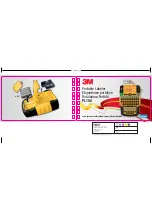
somewhat differently and are as follows:
•
Liquid measurements:
The measuring cup must be placed on
a horizontal flat surface and viewed at
eye level (not at an angle) when read-
ing amounts. The liquid level line must
be aligned to the measurement mark. A
‘guesstimate’ is not good enough as it
could throw out the critical balance of
the recipe.
•
Dry measurements:
Dry measurements (especially flours)
must be done using the measuring cup
provided. The measuring cup is based
on the American standard 8 fluid oz
cup, British cup is 10 fluid oz. Dry
measuring must be done by gently
spooning ingredients into the measu-
ring cup and then once filled, levelling
off with a knife. Scooping or tapping the
measuring cup will pack the ingredients
and you will end up with more than is
required. This extra amount could affect
the balance of the recipe. Do not sift the
flour, unless stated.
When measuring small amounts of dry
or liquid ingredients (ie. yeast, sugar,
salt, powdered milk, honey, molasses)
the measuring spoon which is provided
must be used. Measurements must be
level, not heaped as this small differ-
ence could throw out the critical bala-
nce of the recipe.
This appliance produces delicious
baked goods with ease. The appliance
only requires that you carefully follow
the recipe’s instructions. In basic cook-
ing, normally ‘a pinch of this and a dash
of that’ is fine, but not for this appliance.
Using an automatic breadmaker
requires that you accurately measure
each ingredient for the best results.
Ingredient temperatures:
All ingredients, including this appliance,
its baking pan, and especially liquids (wa-
ter or milk), should be warmed to room
temperature 21°C (70°F). If ingredients
are too cold, below 10°C (50°F), they
will not activate the yeast. Extremely hot
liquids, above 40°C (104°F), may kill the
yeast.
Creating your own yeast breads:
With this appliance, even the most inex-
perienced baker can achieve the satisfy-
ing experience of baking a loaf of bread.
All of the mystery and hard work is gone.
The electronic brain inside this sophisti-
cated appliance will ensure that dough is
mixed, kneaded, proofed and baked with-
out you being present. The breadmaker
can also prepare dough, and when it is
ready, all you have to do is shape it, allow
it to rise and then bake in a conventional
oven. The recipes on the following pages
are ‘tailored’ for this breadmaker. Each
recipe features ingredients that best
compliment a particular type of bread,
and each recipe has been tested in this
appliance. It is extremely important to
not exceed the amounts of ingredients
specified in each of the recipes because
it can result in unsatisfactory baking per-
formance. When creating your own yeast
bread recipes or baking an old favourite,
use the recipes in this instruction manual
for converting portions from your recipe
so that it will suit your breadmaker.
26500_IM.indd 13
2012/11/26 02:34:17 PM












































